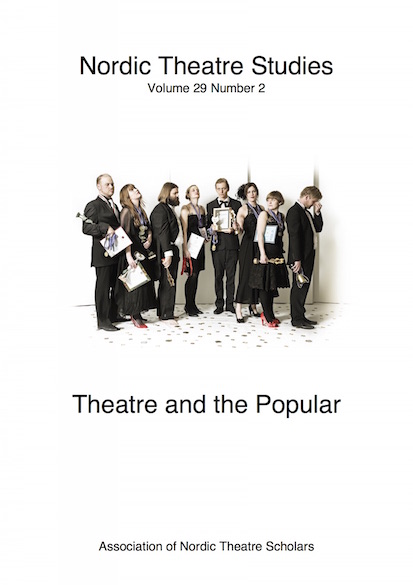Popular Theatre - Highbrow or Lowbrow
DOI:
https://doi.org/10.7146/nts.v29i2.104605Keywords:
Henrik Ibsen, Nineteenth-century Norwegian theatre, Audience and class, En KapriceAbstract
For 13 years, from 1851 to 1864, Ibsen worked full time at the Norwegian theatres in Bergen and Christiania (Oslo) as a stage director and theatre manager. Ibsen’s period in the theatre and the repertory he staged have seldom enjoyed much attention in scholarly research. The reason for this has been that the repertory Ibsen staged has been seen as vulgar and lowbrow, and Ibsen’s period in the theatre has almost unanimously been seen as a waste of time. The general understanding has been that Ibsen’s development as an artist had been much faster if he had been working with a highbrow repertory of serious drama.
Contrary to this established opinion I will contribute to the discussion of popular theatre as highbrow or lowbrow by presenting the production A Caprice (En Kaprice) by Erik Bøgh, staged by Henrik Ibsen at the Norwegian Theatre in Christiania (Oslo). It premiered 7 September 1859 and then ran for another thirty-five performances during the 1859-60 season. The total number of attendances was more than 30.000. In relation to the population of the town of 42.000, it was about 2/3 or 67%. This is the by far largest box-office success in Norwegian theatre history. No wonder that Ibsen scholars generally have understood A Caprice as the ultimate example of the unholy trade Ibsen was forced into as a theatre manager. According to Michael Meyer Ibsen for the only time in his life “rebuked for truckling to the box-office” (Meyer 1971, 166). The contemporary criticism in Morgenbladet (Nr. 278, 9.10.1859) claimed that Ibsen was declining the Norwegian Theatre in Christiania into a kind of amusement ground for the lower classes.
I will, however, present A Caprice as the summit of Ibsen’s theatrical career and underline that both this and other dance productions staged by Ibsen in this period, were not at all amusement for the lower classes but on the contrary important expressions of his artistic creativity and development – and actually a highbrow performance presented for an upper class audience.References
Andersen, Anette Storli. 2010a. “Deus ex machina? Henrik Ibsen og teatret i norsk offentlighet 1780-1864.” PhD thesis. Oslo University.
Andersen, Anette Storli. 2010b. “Theatrical Worldmaking. How the Norwegian Constitution was Prepared within the Theatre.” Birgit Neumann, Ansgar Nünning and Vera Nünning (eds.). The Aesthetic and Politics of Cultural Worldmaking. Giessen Contributions to the Study of Culture 3. Trier: Wissenschaftlicher Verlag, 49-62.
Andersen, Anette Storli. 2013. “Teatret og Riksforsamlingen i 1814. De handlende personers kunst.” N. Langeland (ed). Politisk kompetanse: Grunn-lovas borgar 1814-2014. Oslo: Pax, 280-303.
Andersen, Anette Storli. 2014. ““Enige og troe til Dovre falder”: Om iscenesettelsen av en klippefast nasjon.” Nordisk tidskrift för vetenskap, konst og industri. 90: 2, 167-174.
Andersen, Anette Storli. 2015. “Theatre, patriotism, and politics in Denmark-Norway, 1772-1814.” Ellen Krefting, Aina Nøding and Mona Ringvej (eds.). Eighteenth-Century Periodicals as Agents of Change: Perspectives on Northern Enlightenment. Leiden & Boston: Brill, 215-235.
Andersen, Anette Storli and Nygaard, Jon. 2008. “Teaterkritikkens utvikling fra ‘innvendig’ til ‘utvendig’. Hvilke institusjonelle forhold har ligget til grunn for tilblivelsen og utøvelsen av teaterkritikk i Norge?” Paper presented at Tyrifjordseminaret 8.5-9.5.2008. Program for aesthetic studies, University of Oslo.
Anker, Øyvind. 1956. Kristiania Norske Theaters Repertoire 1852–1863. Oslo: Gyldendal, 1956.
Anker, Øyvind. 1958. Johan Peter Strømberg. Mannen bak det første offentlige teater i Norge. Oslo: Gundersen 1958.
Bourdieu, Pierre. 1984. Distinction: A Social Critique of the Judgement of Taste. Translated by Richard Nice. London & New York: Routledge.
Collet, Alf. 1909. Gamle Christiania-billeder. Christiania: Cappelen.
Damsholt, Tine. 2000. Fædrelandskærlighed og borgerdyd. Patriotisk diskurs og militære reformer i Danmark i sidste del av 1700-tallet. Copenhagen: Museum Tusculanum.
Eliassen, Finn-Einar. 2006. Småbyenes storhetstid ca. 1500-1830. Oslo: Pax.
Gjervan, Ellen Karoline. 2010. “Creating Theatrical Space: A Study of Henrik Ibsen’s Production Books. Bergen 1852-1857.” PhD thesis. University of Bergen.
Ibsen, Henrik. 1928-57. Samlede verker. Hundreårsutgave. Oslo: Gyldendal.
Lund, Audhild. 1925. Henrik Ibsen og det norske teater. Oslo. Malling.
Mai, Anne-Marie. 1994. Moralske fortællinger 1761–1805. Copenhagen: Borgen.
Meyer, Michael. 1971. Ibsen: A Biography. Garden City, NY: Doubleday.
Monrad, Marcus Jacob. 1854. “Om Theater og Nationalitet og om en norsk dramatisk Skole.” Norsk Tidskrift for Videnskab og Litteratur 7, 1-33.
Myhre, Jan Eivind. 1990. Hovedstaden Christiania: Fra 1814 til 1900. Oslo: Cappelen.
Myhre, Jan Eivind. 2016. Christiania 1814. Ravnekrok blir hovedstad. Oslo: Akademisk publisering.
Norges officielle statistik. Fjerde Række Nr. 111. Folketællingen I Kongeriget Norge 3 December 1900. Femte Hefte. Folkemængde fordelt efter Livsstilling. Udgivet af Det statistiske Centralbureau. I kommission hos H. Aschehoug & Co, Kristiania 1905.
Rahbek, Knud Lyne. 1788. “Om Privattheatrenes Bestemmelse, Nytte, og Skade.” K. L. Rahbek (ed.). Dramaturgiske Samlinger 1. Copenhagen: Johan Frederik Schultz.
Resultaterne af folketællingen i Norge i januar 1866. Udgivne af Departementet for det Indre. Trykt i det Steenske bogtrykkeri, Christiania 1869.
Rothe, Tyge. 1759. Tanker om Kiærlighed til Fædernelandet. Copenhagen: Nicolaus Møller.
Svarstad, Elisabeth and Nygaard, Jon. 2016. “A Caprice: The Summit of Ibsen’s Theatrical Career.” Ibsen Studies 16:2, 168-185. DOI: 10.1080/15021866.2016. 1263445
Tabeller over Folkemængden i Norge den 31te December 1855. https://www. ssb.no/a/histstat/nos/st_16r_1846-55.pdf
Downloads
Published
How to Cite
Issue
Section
License
The copyright belongs to the authors and Nordic Theatre Studies. Users can use, reuse and build upon the material published in the journal but only for non-commercial purposes. Users are allowed to link to the files, download the files, distribute the files on a local network (preferably by links), upload the files to local repositories if their institutions require them to do so, but not republish the files without proper agreements with the journal and the author.

